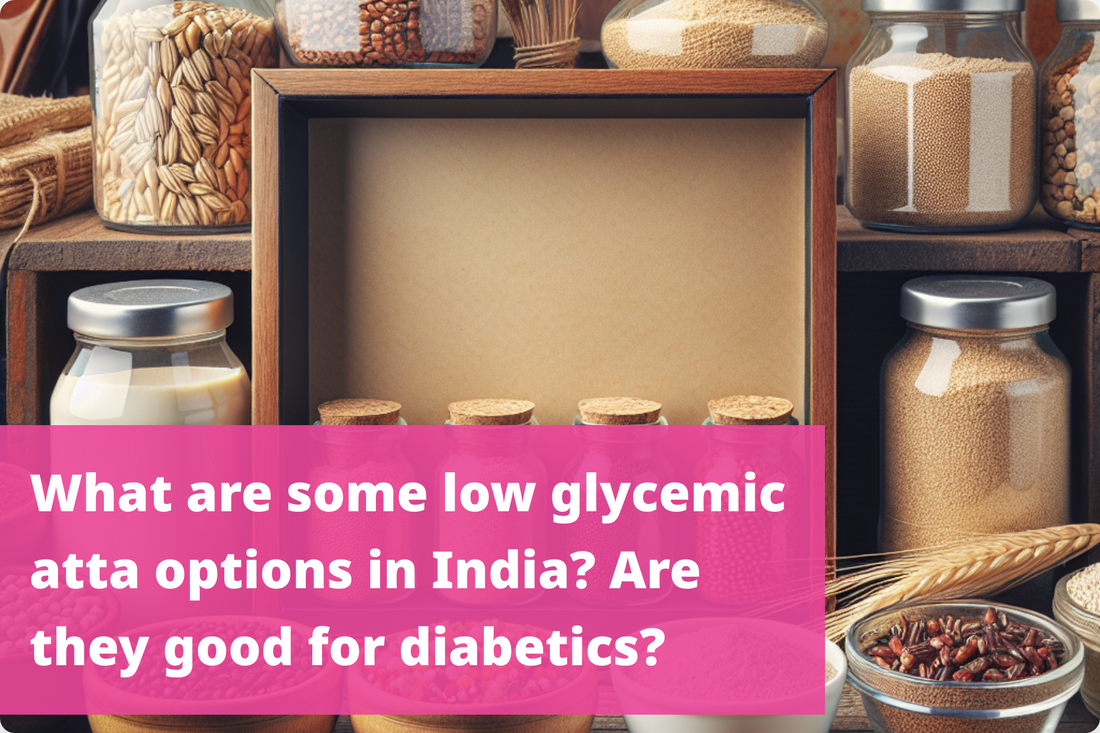In our quest for a healthier lifestyle, understanding the glycemic index becomes crucial, especially for those managing diabetes. The glycemic index, or GI, is a measure of how quickly a food raises blood glucose levels. For individuals with diabetes, keeping these levels stable is key to overall well-being.
Choosing low glycemic atta options in India is a thoughtful approach to managing blood sugar levels. Atta, a staple in Indian households, plays a significant role in our daily diet. Being mindful of the glycemic index of atta can make a substantial difference in the lives of those navigating the challenges of diabetes.
As we delve into this exploration, it's important to recognize that making informed choices about our food can be empowering. Join us as we unravel the intricacies of the glycemic index and explore the relevance of opting for low glycemic atta options in the Indian context. Your journey to a healthier lifestyle starts with the choices you make in your kitchen.
Understanding Atta and Glycemic Index
Atta, a fundamental ingredient in Indian cuisine, goes beyond being just a flour; it's a cornerstone of our daily meals. Derived from wheat, atta serves as the base for various staples like chapatis and rotis. Its versatile nature makes it an integral part of our culinary traditions, offering not just sustenance but a cultural connection.
Now, let's talk about the glycemic index. This concept measures how quickly carbohydrates in food raise blood glucose levels. High glycemic foods can cause rapid spikes and crashes in blood sugar levels, posing a challenge for individuals with diabetes.
Imagine this: you consume a high glycemic food, and your blood sugar soars. Soon after, there's a sudden dip, leaving you feeling fatigued and craving more food. It's a rollercoaster that can be particularly challenging for those trying to maintain stable blood sugar levels.
By understanding atta and the glycemic index, we gain insights into the impact our food choices can have on our health. It's not just about what we eat but how it affects our well-being in the long run. Let's unravel the connection between atta, the glycemic index, and our journey towards healthier eating.
Glycemic Index of Common Attas
Heres a comparison chart for Low glycemic atta options that can be used.
Type of Atta |
Description |
Glycemic Index (GI) |
Nutritional Benefits |
Best Uses |
|---|---|---|---|---|
Whole Wheat Atta |
Made from whole wheat grains, including bran, germ, and endosperm. |
30-50 |
High in fiber, B vitamins, iron, magnesium, and antioxidants. |
Rotis, parathas, bread |
Bajra (Pearl Millet) Atta |
Ground from pearl millet, a common grain in Indian cuisine. |
54 |
Rich in fiber, protein, iron, calcium, and magnesium. |
Bhakri, rotis, porridge |
Jowar (Sorghum) Atta |
Made from sorghum grains, a drought-resistant crop. |
62 |
High in fiber, protein, antioxidants, and B vitamins. |
Rotis, bhakri, baked goods |
Ragi (Finger Millet) Atta |
Made from finger millet, known for its reddish color and nutritional value. |
54 |
High in calcium, fiber, iron, and essential amino acids. |
Dosas, rotis, porridge, baked goods |
Barley Atta |
Ground from barley grains, a cereal grain with high nutritional value. |
28 |
Rich in fiber (especially beta-glucan), vitamins, and minerals; helps lower cholesterol. |
Rotis, porridge, soups |
Quinoa Atta |
Made from ground quinoa seeds, known as a superfood. |
53 |
High in protein, fiber, vitamins, minerals, and antioxidants; gluten-free. |
Rotis, bread, pancakes, baked goods |
Chana (Chickpea) Atta |
Made from ground chickpeas, also known as besan or gram flour. |
35 |
High in protein, fiber, and essential nutrients like folate, iron, magnesium, and zinc. |
Rotis, pancakes, pakoras, chillas |
Soybean Atta |
Made from ground soybeans, often mixed with wheat flour for baking. |
15-20 |
High in protein, fiber, vitamins, and minerals; low in carbs; good for heart health. |
Rotis, bread, pancakes, baked goods |
Oats Atta |
Made from ground oats, known for their heart-healthy properties. |
55 |
High in soluble fiber (beta-glucan), which helps reduce cholesterol; rich in protein and antioxidants. |
Rotis, bread, pancakes, baked goods |
Amaranth Atta |
Made from ground amaranth seeds, a nutritious pseudo-cereal. |
35 |
High in protein, fiber, calcium, iron, magnesium, and antioxidants; gluten-free. |
Rotis, bread, pancakes, baked goods |
Now, let's dive into the glycemic index of some commonly used attas in India. The choices we make in our kitchen can significantly impact our blood sugar levels, and being aware of the glycemic index helps us make informed decisions.
Firstly, atta maggi, a quick and convenient option, may have a higher glycemic index compared to traditional atta. It's essential to balance its consumption, especially for those focusing on glycemic control.
Atta Roti, a staple in many Indian households, usually has a lower glycemic index compared to refined flour options. Opting for Atta roti can be a smart move for individuals aiming to manage their blood sugar levels effectively.
Multigrain atta, often marketed as a healthier alternative, combines various grains, each with its unique glycemic index. While it may offer a mix of nutrients, it's essential to understand how it influences blood sugar levels.
Ragi Atta, made from finger millet, is gaining popularity for its nutritional benefits. It tends to have a lower glycemic index, making it a favorable choice for those looking to control blood sugar.
Daibesmart’s Diabetic Care Atta on the other hand has 90% reduced glycemic load which gives you a 50% less sugar spike post consumptions. It's also high in protein.
By comparing and contrasting these attas, we can make conscious choices that align with our health goals. Let's decipher the glycemic puzzle and pave the way for mindful eating in our everyday lives.
Benefits of Low Glycemic Attas for Diabetics
Now, let's unravel the benefits of embracing low glycemic atta options, especially for those managing diabetes. The impact of our food choices on blood sugar levels cannot be overstated, and opting for low glycemic atta can be a game-changer for overall health.
Stable Blood Sugar Levels: Low glycemic attas release glucose into the bloodstream gradually, preventing sudden spikes. This steady release helps in maintaining stable blood sugar levels, a crucial factor for individuals with diabetes.
Sustained Energy: Unlike high glycemic foods that provide a quick energy boost followed by a crash, low glycemic attas offer sustained energy. This can contribute to improved stamina and reduced feelings of fatigue throughout the day.
Weight Management: For individuals with diabetes, weight management is often a key aspect of overall health. Low glycemic attas, by promoting a feeling of fullness and reducing cravings, can aid in weight control and support overall well-being.
Heart Health: Diabetes and heart health often go hand in hand. Choosing low glycemic atta options can positively impact cardiovascular health by regulating blood sugar levels and lowering the risk of heart-related complications.
Nutrient-Rich Choices: Many low glycemic attas, such as ragi atta, come with additional nutritional benefits. These may include higher fiber content, vitamins, and minerals, contributing to a well-rounded and healthy diet.
Incorporating low glycemic atta into the daily diet is a simple yet effective step towards better blood sugar control and improved overall health. It's about making choices that resonate with your well-being goals, one atta at a time.
Empowering healthy choices through Low GI Atta
In conclusion, our journey through the glycemic landscape of atta unveils essential insights for those navigating the challenges of diabetes. The glycemic index plays a pivotal role in understanding how our food choices impact blood sugar levels, and when it comes to atta, knowledge is indeed power.
We've explored the diverse glycemic indices of common attas in India – from the convenience of atta maggi to the traditional atta roti, the multigrain blend, and the nutrient-rich ragi atta. Each choice holds implications for blood sugar control, urging us to make decisions that align with our health objectives.
For individuals managing diabetes, the benefits of opting for low glycemic attas are substantial. From stabilizing blood sugar levels and sustaining energy to supporting weight management and promoting heart health, these choices extend beyond the kitchen into our overall well-being.
As we wrap up, the message is clear: the atta we choose matters. Making informed decisions about our dietary staples empowers us to take charge of our health. So, whether you're crafting a roti or exploring the versatility of multigrain atta, consider the impact on your blood sugar levels. It's not just about what's on your plate; it's about the journey towards a healthier, well-balanced life. Choose wisely, and let your atta be an ally in your quest for well-being.
This Blog post is an initiative by DiabeSmart, to provide accurate and Nutritionist / Doctor approved information related to Diabetes. DiabeSmart is India's first Food brand designed specifically for Diabetics, that has been clinically tested on Diabetics and Pre-Diabetics to deliver 55% - 70% lower Sugar spikes. DiabeSmart is part of Lo! Foods - India's leading brand for Everyday Functional Health foods.











